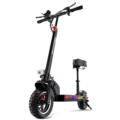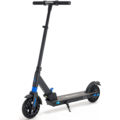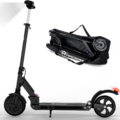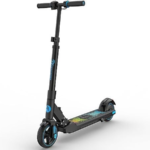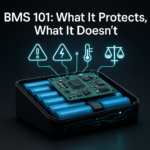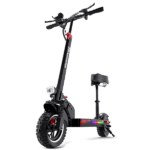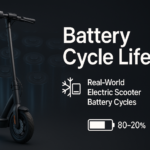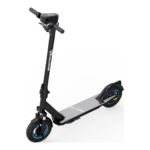- Home
- Scooters
- Electric Scooters
- EVERCROSS H9
EVERCROSS H9
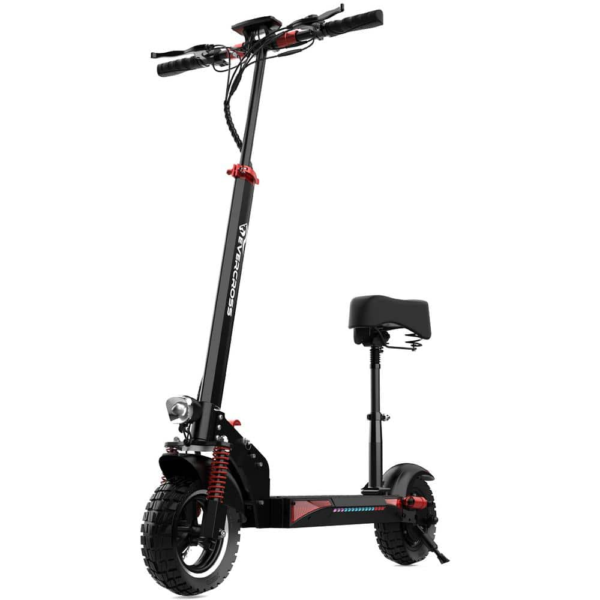

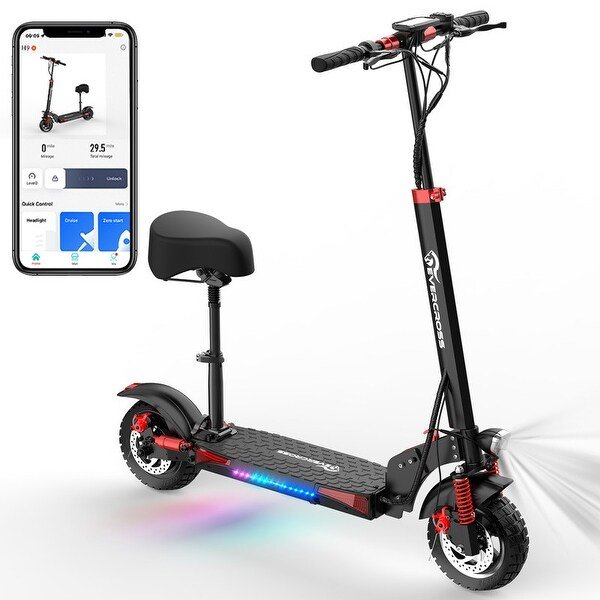
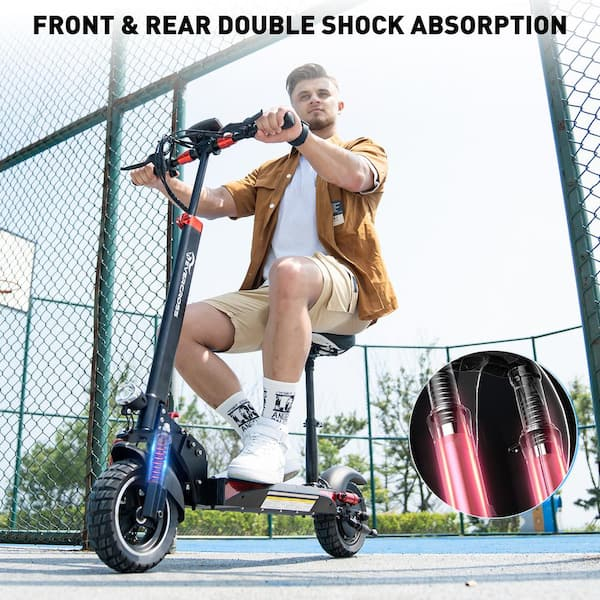
- Battery Range: 28 miles (45 km)
- Top Speed: 28 mph (45 km/h)
- Motor Power: 800 W
- Weight Capacity: 330 lb (150 kg)
- Charging Time: ~6–8 h
- Scooter Weight: 54.4 lb (24.7 kg)
PROS
- 48V 14Ah battery
- 28 mph top speed
- Front & rear suspension
- Seat included/ready
- Front & rear disc brakes
CONS
- Solid tires reduce comfort
- IP rating not specified
- Heavier than commuter models


Table of contents
- What Is the EVERCROSS H9?
- How the EVERCROSS H9 Works
- Key Specifications
- Design & Build Quality
- Performance Fundamentals
- Battery, Range & Efficiency
- Ride Quality & Comfort
- Braking & Safety Features
- Portability & Daily Usability
- Maintenance & Care
- Weather & Seasonal Considerations
- EVERCROSS H9 vs Alternatives
- Who the EVERCROSS H9 Is (and Isn’t) For
- FAQs
- Glossary
- Final Thoughts
The EVERCROSS H9 is a high-output, full-size adult scooter built for riders who want real speed and reliable everyday practicality. It combines a robust brushless hub motor, a 48V battery, dual disc brakes, and 10-inch solid tires. As a result, it delivers punchy acceleration with low-maintenance running. Consequently, it suits commuters and recreational riders who value stability, a seated option, and app-enabled control without the upkeep of pneumatic tires. Finally, it presents its key specifications clearly, so new riders can understand what they’re getting.
What Is the EVERCROSS H9?
At its core, the EVERCROSS H9 is a 48-volt, performance-leaning commuter scooter. It uses a rated 500-watt brushless hub motor with 800-watt peak bursts, front and rear disc brakes, and solid 10-inch tires. Additionally, it pairs with a mobile app for locking, cruise control, and speed settings. In many packages, it also ships with a detachable seat for longer rides. Because the H9 offers three ride modes, you can cap speed in busy areas or unlock brisk performance on open paths.
Furthermore, the chassis is larger than a typical last-mile scooter. Therefore, you get a broad deck, a tall cockpit, and a stable stance at speed. If you’re crossing a spread-out campus, handling a medium-distance commute, or mixing bike lanes with quiet streets, this model offers a convincing blend of power and practicality. Meanwhile, the suspension and the rigid tires balance comfort and durability, so flat repairs rarely interrupt your week.
How the EVERCROSS H9 Works
Understanding the system helps you ride smoothly and maintain the scooter effectively.
- Motor & Controller. A brushless DC hub motor draws power from a 48V controller. Think of the controller as the scooter’s brain and gatekeeper; it meters current, protects the battery, and smooths throttle requests. Consequently, the motor delivers predictable pull. Rated output is 500 W with 800 W peak for short bursts, which explains the lively jump off the line.
- Battery & Power Delivery. The 48V, 14Ah pack stores about 672 watt-hours (Wh). Because higher voltage helps the motor make torque at lower current, heat and voltage sag are reduced. Therefore, the H9 holds speed better than many 36V budget scooters on rolling terrain.
- Throttle. A right-side thumb paddle translates your input into a controller signal. Light presses bring gentle roll-on; deeper presses call for stronger current. As a result, you can meter power precisely in bike lanes or neighborhood traffic.
- Brakes. Mechanical disc brakes front and rear provide direct stopping force. Since discs clamp a dedicated rotor, they remain consistent in wet or dry conditions when adjusted correctly. Moreover, lever feel is easy to tune with simple cable tweaks.
- App & Modes. Pairing the scooter enables locking, cruise control, and speed limits. You can enable “zero-start” (throttle from a standstill) or “non-zero-start” (kick-to-go). Additionally, you can step through three speed modes capped at roughly 9.3 mph (15 km/h), 19 mph (30 km/h), and 28 mph (45 km/h) when fully uncapped for lighter riders.
Altogether, these systems make the H9 intuitive. Press the throttle and it pulls; squeeze the levers and it slows; glance at the display to check battery and mode. In short, that’s the everyday rhythm.
Key Specifications
The figures below reflect manufacturer-published data, shown in both imperial and metric.
| Block | Item | Value |
|---|---|---|
| General | Model | H9 |
| Intended rider age | 15+ years | |
| Max load | 330 lb (150 kg) | |
| Recommended load | 100–220 lb (45–100 kg) | |
| Tire type | 10-inch solid (maintenance-free) | |
| Performance & Power | Motor (rated / peak) | 500 W / 800 W brushless hub |
| Top speed — General mode | ~15.5 mph (25 km/h) | |
| Top speed — Sport mode | ~28 mph (45 km/h)* | |
| Stated max incline | ~15% (moderate urban hills) | |
| Battery, Charging & Electrical | System voltage / capacity | 48V, 14Ah (~672 Wh) |
| Charge time | ~6–8 hours | |
| Display & modes | 3 speed modes, cruise control, app lock | |
| Build & Dimensions | Unfolded size (L × W × H) | 49.6 × 30.0 × 49.2 in (126.0 × 76.2 × 125.0 cm) |
| Folded size (L × W × H) | 49.6 × 17.3 × 12.6 in (126.0 × 44.0 × 32.0 cm) | |
| Net weight | ~54.4 lb (24.7 kg) | |
| Gross shipping weight | ~66.5 lb (30.2 kg) | |
| Safety & Control | Brakes | Front & rear mechanical disc |
| Lights & signals | Headlight, tail light, turn signals, side lights | |
| Suspension | Dual spring / hydraulic shock elements front & rear | |
| Features & Extras | App functions | Lock, cruise control, speed modes, zero-start, lights |
| Cockpit | Thumb throttle, lever brakes, clear instrument screen | |
| Seat | Detachable seat option included in many packages | |
| Warranty & Compliance | Warranty | Seller-dependent; see purchase documents |
| Water resistance | No official IP rating listed | |
| Local rules | E-scooter regulations vary by region |
* The 28 mph (45 km/h) target assumes a lighter rider (around 165 lb / 75 kg) in Sport mode.
Accordingly, actual results vary with terrain, temperature, and rider posture.
In this Key Specifications block, the term “specifications” is used to match common buyer expectations.
Design & Build Quality
Frame & Geometry. The H9 uses a reinforced deck and a tall stem to create a stable, roomy platform. Because the wheelbase is generous, straight-line tracking feels calm at urban speeds. Meanwhile, the metalwork and latch design favor solidity over ultra-fast one-hand folds, which makes sense on a heavier scooter.
Deck. The deck is broad and grippy. As a result, you can plant both feet forward in parallel for cruising. Alternatively, you can shift to a diagonal stance when you want a touch more weight over the front wheel for cornering.
Stem & Latch. The folding stem locks into a robust collar. Once you learn the motion, the latch engages cleanly. Consequently, flex and squeaks are minimized. If you ride daily, a quick weekly check keeps the joint tight and confidence high.
Cockpit. Controls are straightforward. The thumb throttle sits on the right, with brake levers at both grips. Because the display is bright and legible, reading mode, battery, and speed is simple even in daylight. Furthermore, buttons for lights and mode changes are easy to reach with gloves.
Fit & Finish. Panel gaps are tight and hardware is well-chosen. Since solid tires transmit more vibration than pneumatic ones, the factory choice to use dual shocks on both ends pays off. After initial setup, bolts stay put if you follow a simple torque-check routine.
Performance Fundamentals
Launch & Mid-Range. The EVERCROSS H9 steps away cleanly in its lower modes and feels assertive in Sport. As the controller feeds the motor more current, you get a firm mid-range pull. Because wind resistance rises quickly at higher speeds, acceleration tapers near the top end. Even so, the scooter remains responsive enough for safe merges when you plan ahead.
Cruising Stability. At neighborhood speeds, the chassis tracks straight with little steering twitch. As you approach the upper 20s (mph), stability stays respectable for a commuter-class machine, provided the stem latch is properly adjusted and the tires are in good condition. Moreover, a relaxed upper body and light grip help the front end stay calm over patched asphalt.
Hill Behavior (~7–10% Grades). On moderate grades, the H9 maintains speed in Sport mode better than 36V scooters because of its 48V system and peak power overhead. However, expect speed to drop on longer climbs, especially for heavier riders. Therefore, carrying momentum before the incline and choosing the right mode both help the scooter churn up the hill without drama.
Battery, Range & Efficiency
Battery Pack. The 48V, 14Ah pack equates to about 672 Wh of stored energy. Because voltage and capacity work together—voltage “pushes,” capacity “sustains”—the H9 blends useful speed with practical distance.
Rated vs Real-World Range. Manufacturer literature often quotes up to around 28 miles (45 km) under ideal conditions. In practice, real-world numbers vary widely:
- Rider weight. Heavier loads draw more current at a given speed; therefore, range shrinks.
- Terrain & stops. Frequent starts, headwinds, and long climbs increase consumption.
- Temperature. Cold reduces available capacity; extreme heat stresses cells.
- Speed choice. Riding in Sport at 25–28 mph consumes energy far faster than cruising at 15–18 mph.
Consequently, a mixed-pace urban ride for an average adult on rolling terrain often nets a comfortable 15–22 miles (24–35 km) before recharging. If you choose lower modes on flatter routes, the number moves higher.
Charging Best Practices.
- Let the pack rest at room temperature before and after charging. This stabilizes cells.
- Aim for partial charges (30–80%) when daily needs are modest; this reduces stress.
- For storage over a week, park around 50–60% state of charge.
- Avoid leaving the charger connected long after the green light; it adds no benefit.
By following these habits, you moderate cell wear and keep the pack healthier across seasons.
Ride Quality & Comfort
Tires. Solid 10-inch tires eliminate flats and most air-leak maintenance. The trade-off is higher transmitted vibration over coarse pavement and expansion joints. Fortunately, the H9’s front and rear shock elements blunt sharp edges. Therefore, the ride lands between plush pneumatic setups and harsh solid-only scooters.
Suspension. Dual spring/shock units take the sting out of potholes and sidewalk seams. Although you still feel the surface, the chassis does not skip sideways over sharp bumps when your speed and line are sensible. Additionally, the suspension lets you hold a seated posture without excessive jarring.
Ergonomics. The cockpit height suits most adult riders. A seated option is a genuine perk on longer rides or when nursing a knee. Hand grips are comfortable, and lever reach works for small and large hands once adjusted. Moreover, the broad deck allows micro-shifts that relieve foot fatigue.
Stem Flex. Properly tightened, the stem resists wobble under braking and at cruise. If you notice play, bring the latch into spec immediately. Because the adjustment is simple, a few minutes with the included tools restores that locked-in feel.
Braking & Safety Features
Brakes. Mechanical discs at both wheels deliver predictable stopping with an easy lever squeeze. Bite comes on progressively. After the first half-pull, clamp force ramps quickly, which helps you scrub speed before intersections. With a brief tuning session for lever reach and cable tension, you can shorten stopping distance and reduce finger fatigue.
Lighting & Signals. The headlight is bright enough to mark your presence and pick lines at urban speeds. Tail and side lighting improve visibility at oblique angles. Because integrated turn signals add clear communication in traffic, make them a habit like on a bicycle. Additionally, reflective side accents increase visibility at night.
Weather. The H9 lacks a published IP rating. Therefore, treat rain as a caution flag. If you get caught in light drizzle, keep speeds modest, avoid puddles, and dry the scooter thoroughly—especially around the deck seam, charge port, and cockpit buttons—before charging.
Speed Management. Speed modes act like gears. Use the lowest mode on crowded paths, step to the middle for neighborhood streets, and reserve Sport for open, predictable stretches. Furthermore, cruise control is helpful on steady bike-lane runs; be ready on the brake to disengage instantly.
Portability & Daily Usability
Weight & Carrying. At about 54 lb (24.7 kg) net, the EVERCROSS H9 is portable but not a featherweight. Short stair flights are doable if you lift from the stem and deck together. For longer carries, roll the scooter to elevators or ramps. Consequently, multi-modal riders can still combine it with trains or rideshares.
Folding & Storage. The latch is straightforward once you learn the sequence. Folded dimensions—roughly 49.6 × 17.3 × 12.6 inches—fit under many desks and in wagon-style trunks. At home, a wall hook or floor stand keeps it tidy and off the walkway. Additionally, removing the seat post reduces height and visual bulk.
Security Habits. Use the app’s lock as a deterrent, then add a hardened U-lock through the frame or a heavy chain around a fixed anchor. Because the seat can attract attention, remove it if you’ll be away for hours. Finally, store the charger separately to avoid opportunistic theft.
Maintenance & Care
Weekly (or every ~30 miles / 50 km).
- Check stem latch tightness; eliminate any play. Consequently, wobble stays away.
- Inspect brake pads and cable tension; adjust until engagement feels firm.
- Wipe the deck and underbody; look for loose fasteners or rubbing cables.
Monthly.
- Re-torque hardware: axle nuts, caliper bolts, stem clamp, deck screws.
- Spin wheels to confirm they’re true and free of debris.
- Test lights and signals. Replace any dim bulbs or cracked lenses.
Battery Habits.
- Keep the pack between 20% and 85% for everyday use.
- Avoid charging immediately after a hard ride; let it cool to room temperature first.
- If storing for winter, top up to about 60% every 4–6 weeks. Consequently, cell voltage stays in a healthy band.
Firmware/App.
- Open the app monthly to check for updates or parameter drift.
- Confirm your preferred zero-start setting after any reset. Otherwise, the throttle may behave differently.
Solid Tire Notes.
- You won’t top up air, but you should still inspect treads for cuts and embedded objects. Solid tires can chunk if abused on sharp curbs; therefore, a quick glance prevents surprises.
Altogether, this routine keeps the scooter tight, safe, and quiet.
Weather & Seasonal Considerations
Rain. Without a formal IP rating, heavy rain is best avoided. If you must ride, brake earlier, steer smoothly, and skip puddles. Afterwards, dry the scooter completely and wait before charging. Consequently, electrical components remain protected.
Heat. In hot summers, don’t leave the H9 baking in direct sun. Heat accelerates cell aging and can soften plastics. Instead, park in the shade and let the deck cool before plugging in.
Cold. Expect range to drop near freezing. Pre-warm the battery indoors for 15–20 minutes before riding. Then, use lower modes and a steady throttle to ease the load. Additionally, plan shorter trips or a midday charge during cold snaps.
Traction. Solid rubber hardens in the cold. Therefore, smooth inputs—gentle throttle and gentle brakes—keep grip predictable on chilled pavement.
EVERCROSS H9 vs Alternatives
Where the H9 excels.
- You want speed headroom above 18–20 mph with stable manners.
- You prefer flat-resistant solid tires and can accept a firmer ride.
- You like an included seat and a larger deck for comfort.
- You value dual disc brakes and bright integrated signaling.
Where a commuter-first model might win.
- Daily elevator carries or long walk-ups: a 30–40 lb scooter is easier.
- You prize plush ride above all else: air-tire commuters soak up chatter better.
- Your route is short and slow: a simpler 36V model may be lighter and more efficient.
Where performance/off-road classes differ.
- True performance scooters bring dual motors, hydraulic brakes, and far more weight. They surge harder and track in rough stuff, but they’re overkill for many city errands.
- Off-road-leaning models add knobbier tires and longer travel, which help on trails but add noise and rolling resistance on smooth bike paths.
If you prefer a lighter, simpler ride for short urban hops, consider the EVERCROSS EV08E. Likewise, the EVERCROSS E8 emphasizes easy portability and straightforward commuting.
Who the EVERCROSS H9 Is (and Isn’t) For
Great for:
- Urban and suburban commuters with medium-distance rides.
- Students crossing large campuses who want seated comfort.
- Multi-modal travelers who can roll the folded scooter into trains or rideshares.
- Recreational riders who want weekend speed without heavyweight complexity.
Not ideal for:
- Walk-up apartment dwellers facing several flights daily.
- Riders on broken, cobbled surfaces who need the extra give of pneumatic tires.
- Anyone who must ride in heavy rain; seek a model with a defined IP rating.
Because the H9 balances speed, stability, and maintenance ease, it suits riders who prize dependable performance yet still want manageable size and cost.
FAQs
1) How fast does the EVERCROSS H9 go?
In uncapped Sport mode with a lighter rider, it targets around 28 mph (45 km/h). General mode is limited to about 15.5 mph (25 km/h). As always, obey local rules.
2) What’s the real-world range?
Expect roughly 15–22 miles (24–35 km) for mixed city riding. Speed, hills, temperature, and rider weight shift the number up or down. Consequently, planning a buffer helps avoid range anxiety.
3) Does it have cruise control?
Yes. You can enable cruise control through the cockpit/app and maintain a set speed on steady stretches. A light brake tap disengages it.
4) Can I ride it in the rain?
It has no official IP rating. Therefore, avoid heavy rain, puddles, and post-ride charging until it’s completely dry. Use judgment in light drizzle.
5) Are the tires air-filled or solid?
They’re 10-inch solid tires. You won’t get flats, but ride feel is firmer than pneumatic setups. Fortunately, the dual shocks improve comfort.
6) What’s included in a typical EVERCROSS H9 overview for buyers?
You’ll want to confirm the battery (48V, 14Ah), motor output (500 W rated / 800 W peak), dual disc brakes, suspension, unfolded and folded dimensions, seat option, and lighting. These specifications cover most practical questions.
7) How steep a hill can it climb?
On moderate urban hills around 7–10% grades, it keeps moving in Sport mode, though speed will fall with heavier riders and longer climbs. Therefore, build momentum before the incline.
Glossary
Ah (Amp-hour). A measure of battery capacity—how much charge a pack can hold. Higher Ah generally means longer potential range.
Wh (Watt-hour). Voltage × amp-hours; a direct proxy for energy stored. Useful for comparing range potential across scooters.
Brushless hub motor. An efficient electric motor built into the wheel hub; low maintenance and quiet.
Controller. The electronics that meter power to the motor, protect the battery, and interpret throttle/brake signals.
Voltage (V). Electrical “pressure.” Higher voltage helps the motor produce torque with less current.
Current (A). The flow of electrical charge. More current equals more heat; controllers limit it to protect components.
Zero-start. Throttle engages from a standstill. Non-zero-start requires a small kick before the throttle wakes up.
Regen. Short for regenerative braking. Some scooters use it to recover energy; the H9 focuses on mechanical discs.
Stem flex. The small bending you feel in the handlebar post. Proper latch tension reduces it.
IP rating. Ingress Protection rating for dust and water. No official IP rating is listed for the H9.
Pneumatic vs solid tires. Air-filled tires ride softer and grip well; solid tires resist flats but ride firmer.
Cruise control. A feature that holds a constant speed until you brake or change modes.
Peak power. Short-burst power the motor/controller can deliver for acceleration. It exceeds the continuous “rated” figure.
Mechanical disc brakes. Cable-actuated calipers squeezing a rotor for stopping force—simple, strong, and easy to service.
Speed modes. Software caps that limit acceleration and top speed for different environments.
Deck stance. Foot placement on the deck; small shifts reduce fatigue and improve control.
Final Thoughts
The EVERCROSS H9 occupies a sweet spot for riders who want faster-than-average commutes with stability, a seat option, and minimal tire upkeep. It pairs real-world speed with predictable controls and strong braking. Moreover, its solid-tire/suspension mix keeps flats away while maintaining a civilized ride. If you treat it well and respect local rules, it will carry you briskly across town without fuss. In closing, the H9’s well-rounded specifications make it a dependable choice for many everyday riders.
Specifications
General
| Model The Model specifies the exact version or name of the scooter. It helps identify its unique design, features, and specifications within the manufacturer’s product line. Knowing the model makes it easier to compare options, find compatible accessories, or look up support information. | H9 |
| Brand The Brand identifies the manufacturer or company that designs and produces the scooter. A trusted brand is a sign of quality, reliability, and good customer support. Well-known brands often have higher standards for safety, performance, and after-sales service, giving you more confidence in your purchase. | EVERCROSS |
| Release Date The Release Date indicates when the scooter model was officially launched on the market. This helps you know how current the design, technology, and features are. A newer release date often means updated components, improved performance, and the latest safety or smart features. | 17 November 2025 |
| Recommended Age Recommended Age indicates the minimum age range that the scooter is designed for, based on safety, size, and ease of use. Following the recommended age helps ensure that riders can handle the scooter’s speed, weight, and controls comfortably and safely. Always check local laws and use protective gear, especially for younger riders. | +16 |
Performance & Power
| Motor Power (Wattage) What it means: The motor power, measured in watts (W), shows how strong the scooter’s electric motor is. Why it matters: Higher wattage usually means better acceleration, more torque, and improved performance on hills or rough terrain. For example, a 250W motor is good for flat city roads and light riders, while a 500W or 1000W motor provides more power for faster speeds or climbing steep inclines. | 800 W hub motor |
| Top Speed The Top Speed indicates the maximum speed that the scooter can reach under optimal conditions. It’s usually measured on level ground with a fully charged battery and an average rider weight. A higher top speed allows you to travel longer distances faster, but always ensure you ride within legal speed limits and your personal comfort zone for safety. | 28 mph (45 km/h) |
| Battery Capacity Battery Capacity refers to the total amount of energy the scooter’s battery can store, usually measured in ampere-hours (Ah) or watt-hours (Wh). A higher battery capacity means you can ride longer distances on a single charge, reducing the need for frequent recharging. Keep in mind that actual range can vary depending on rider weight, terrain, speed, and weather conditions. | 48 V 14 Ah (672 Wh) |
| Estimated Range per Charge The Estimated Range per Charge indicates the average distance the scooter can travel on a single full battery charge. This range is calculated under optimal conditions, such as flat terrain, moderate speed, and average rider weight. Real-world range may vary depending on riding style, terrain, weather, and load. A longer range means fewer recharges and greater freedom for longer trips. | 28 miles (45 km) |
| Hill Climb Ability Hill Climb Ability describes the maximum incline or slope that the scooter can handle while maintaining stable performance. It’s typically expressed as a percentage or in degrees. A higher hill climb rating means the scooter can tackle steeper hills without losing too much speed or power. Actual climbing performance may vary based on rider weight, battery charge, and terrain conditions. | 15% |
| Drive System The Drive System refers to how power from the motor is delivered to the wheels. Electric scooters typically use either a hub motor (directly integrated into the wheel) or a chain/belt drive system. A high-quality drive system ensures smooth acceleration, efficient power transfer, and low maintenance. The choice of drive system affects performance, noise level, and overall ride experience. | Not specified |
Charging & Electrical
| Charging Time Charging Time indicates how long it takes to fully recharge the scooter’s battery from empty to 100% using the standard charger provided. Faster charging means less downtime and more time on the road. Actual charging time may vary slightly depending on battery capacity, charger output, and environmental conditions. | Approx. 6–8 hours |
| Battery Type Battery Type refers to the specific technology used in the scooter’s battery, which affects performance, lifespan, weight, and charging time. Most modern electric scooters use high-quality lithium-ion (Li-ion) batteries because they offer a good balance of energy density, durability, and low maintenance. A reliable battery type ensures consistent power delivery and longer riding ranges. | Lithium-ion battery |
| Removable Battery A Removable Battery means the battery pack can be easily detached from the scooter for convenient charging and replacement. This feature allows you to charge the battery separately, swap it with a spare for extended range, or securely store it indoors in extreme weather. Removable batteries add flexibility and make it easier to keep your scooter powered up wherever you are. | Non-removable internal battery (fixed pack) |
| Regenerative Braking Regenerative Braking is an energy-saving feature that converts some of the energy normally lost during braking back into battery power. When you slow down or brake, the motor works in reverse to generate electricity, which helps extend the scooter’s range and improves overall efficiency. This system also reduces wear on traditional brake components, leading to lower maintenance over time. | Not specified |
| Lighting Lighting refers to the built-in front and rear lights that enhance visibility and safety when riding in low-light conditions or at night. Good lighting helps you see the road ahead and ensures that other road users can see you. Many scooters include LED headlights, taillights, and sometimes brake lights or side reflectors for added safety and compliance with local traffic regulations. | LED headlight, rear/brake light, turn signals |
Build & Dimensions
| Scooter Weight Scooter Weight refers to the total weight of the scooter when fully assembled, including the battery. This affects how easy it is to carry, lift, and store the scooter when not in use. A lighter scooter is more portable and convenient for commuting, especially if you need to carry it upstairs or onto public transport. Keep in mind that a sturdy frame and quality components may add to the weight but also contribute to better durability and ride stability. | 54.4 lb (24.7 kg) |
| Maximum Rider Weight Maximum Rider Weight indicates the highest rider weight that the scooter is designed to safely support while maintaining optimal performance and stability. Staying within this limit helps ensure reliable acceleration, braking, and climbing ability, and it protects the frame, suspension, and motor from excessive strain. Exceeding the recommended limit may reduce performance and increase wear on components. | 330 lb (150 kg) |
| Deck Size Deck Size refers to the dimensions of the scooter’s standing platform. A wider and longer deck provides more foot space, allowing you to stand comfortably and adjust your stance while riding. A well-sized deck improves balance and stability, especially on longer rides or at higher speeds. Compact decks, on the other hand, help keep the scooter lightweight and portable. | Reinforced frame with seat post |
| Handlebar Height Handlebar Height refers to the distance from the deck to the handlebars, which affects your riding posture and comfort. An appropriate handlebar height helps you maintain good balance, reduces strain on your back and arms, and makes steering more comfortable. Some scooters have adjustable handlebars to fit riders of different heights, while others have a fixed height for a streamlined design. | Fixed |
| Folding Mechanism The Folding Mechanism describes how easily and securely the scooter can be folded for carrying and storage. A well-designed folding system lets you quickly collapse the scooter into a compact size, making it convenient to transport on public transit, store under a desk, or fit into a car trunk. Look for sturdy latches and safety locks to ensure the scooter stays firmly in place when folded or unfolded. | One-step folding |
| Dimensions Folded Dimensions indicate the size of the scooter when it’s fully folded. This measurement shows how much space the scooter will take up when stored or carried, making it easier to check if it will fit in your car trunk, under a desk, or in a closet. Compact folded dimensions are ideal for commuters who need to bring their scooter on public transport or store it in tight spaces. | Unfolded: 50.0 × 13.0 × 45.6 in (127.0 × 33.0 × 115.8 cm); Folded: 49.6 × 17.3 × 12.6 in (126.0 × 44.0 × 32.0 cm) |
| Material Material refers to the primary construction materials used for the scooter’s frame and key components. High-quality materials like aircraft-grade aluminum, reinforced steel, or durable composites provide strength, stability, and a lighter overall weight. A sturdy material ensures the scooter can handle daily wear and tear while maintaining safety and performance. | Alloy steel |
Safety & Control
| Brake Type(s) Brake Type(s) describe the braking systems the scooter uses to help you slow down or stop safely. Common brake types include mechanical brakes (like drum or disc brakes), electronic brakes, and foot brakes. Many scooters combine multiple braking systems for added safety and shorter stopping distances. The type and quality of brakes affect your control, especially when riding at higher speeds or on slopes. | Front & rear mechanical disc brakes |
| Suspension Suspension refers to the system that absorbs shocks and vibrations while riding, providing a smoother and more comfortable ride over uneven or rough surfaces. Scooters may have front suspension, rear suspension, or dual suspension for better shock absorption and stability. Good suspension helps reduce rider fatigue and improves control, especially when riding on bumpy roads or off-road paths. | Front & rear suspension (hydraulic/coil) |
| Tire Type Tire Type refers to the kind of tires the scooter uses, which directly affects ride comfort, traction, and maintenance. Common types include solid (airless) tires, pneumatic (air-filled) tires, or hybrid options. Pneumatic tires offer better shock absorption and a smoother ride on rough surfaces, while solid tires are puncture-proof and require less upkeep. The right tire type helps ensure safe handling and a comfortable ride in different conditions. | 10″ solid tires |
| Tire Size Tire Size indicates the diameter and width of the scooter’s tires, which affect ride comfort, stability, and how well the scooter handles different terrains. Larger tires generally offer better shock absorption and a smoother ride over bumps and rough surfaces, while smaller tires keep the scooter lighter and more portable. Choosing the right tire size helps ensure a balance between agility and comfort. | 10-inch |
| Kickstand The Kickstand is a built-in stand that allows you to park your scooter upright when it’s not in use. A sturdy kickstand keeps the scooter stable and prevents it from tipping over, protecting it from scratches and damage. It also makes storing and accessing your scooter more convenient, whether you’re at home, work, or on the go. | Side kickstand |
| Water Resistance Rating Water Resistance Rating indicates how well the scooter is protected against water and moisture, usually shown as an IP (Ingress Protection) rating. This rating helps you understand whether the scooter can handle light rain, splashes, or wet roads without damage. While most scooters are not fully waterproof, a good water resistance rating adds peace of mind when riding in changing weather conditions. Always avoid deep puddles or submerging the scooter to protect its electrical components. | Not specified |
Features & Extras
| Display/Console The Display (or Console) shows important real-time information about your ride, helping you monitor your scooter’s status at a glance. Typical displays show speed, battery level, distance traveled, and riding mode. Some models also include additional features like Bluetooth connectivity, app integration, or backlighting for better visibility at night. A clear and easy-to-read display enhances safety and convenience on every trip. | LED/LCD dashboard with speed, battery, modes |
| Ride Modes Ride Modes refer to the different speed and power settings you can choose to match your riding style or road conditions. Common modes include eco for maximum range and energy efficiency, standard for everyday balance, and sport or turbo for higher speed and stronger acceleration. Switching between ride modes allows you to customize performance, conserve battery, and ride safely in various environments. | 3 speed modes |
| Smart App Connectivity Smart App Connectivity lets you pair your scooter with a dedicated mobile app via Bluetooth. Using the app, you can monitor real-time ride stats like speed, battery level, and range, adjust settings such as ride modes or cruise control, lock the scooter for added security, and sometimes receive firmware updates. This feature adds convenience and allows you to personalize your riding experience right from your smartphone. | EVERCROSS PRO app (varies by region) for lock/modes |
| Anti-Theft System The Anti-Theft System helps protect your scooter from unauthorized use or theft. This feature can include built-in alarms, electronic motor locks, GPS tracking, or remote locking through a mobile app. A good anti-theft system provides peace of mind when parking your scooter in public spaces, adding an extra layer of security to safeguard your investment. | App lock |
| Cruise Control Cruise Control allows you to maintain a steady speed without continuously holding the throttle. This feature makes longer rides more comfortable by reducing hand fatigue and providing a smoother, more relaxed riding experience — especially on flat, open roads or bike lanes. For safety, cruise control can usually be easily activated or deactivated while riding. | Yes (cruise control) |
| Accessories Included Accessories Included lists the additional items that come with the scooter to enhance your riding experience and convenience. Common accessories may include a charger, kickstand, bell, lights, phone holder, or carrying strap. These extras add value by making your scooter safer, easier to use, and ready to ride straight out of the box. | Scooter, seat, charger, tools, manual |
Warranty & Compliance
| Warranty Period The Warranty Period indicates how long the manufacturer guarantees the scooter against defects in materials and workmanship under normal use. A good warranty provides peace of mind, showing the brand’s confidence in its product quality. Always check what parts are covered, such as the frame, battery, and motor, and follow the maintenance guidelines to keep your warranty valid. | 12 months (region-dependent) |
| Certifications Certifications confirm that the scooter meets specific safety, quality, and environmental standards set by recognized organizations or regulatory bodies. Common certifications may include CE, RoHS, UL, or other local compliance marks, depending on your region. These certifications ensure that the scooter is manufactured to high standards and is safe and legal to use in your country. | Local micromobility compliance |
Price Comparison




